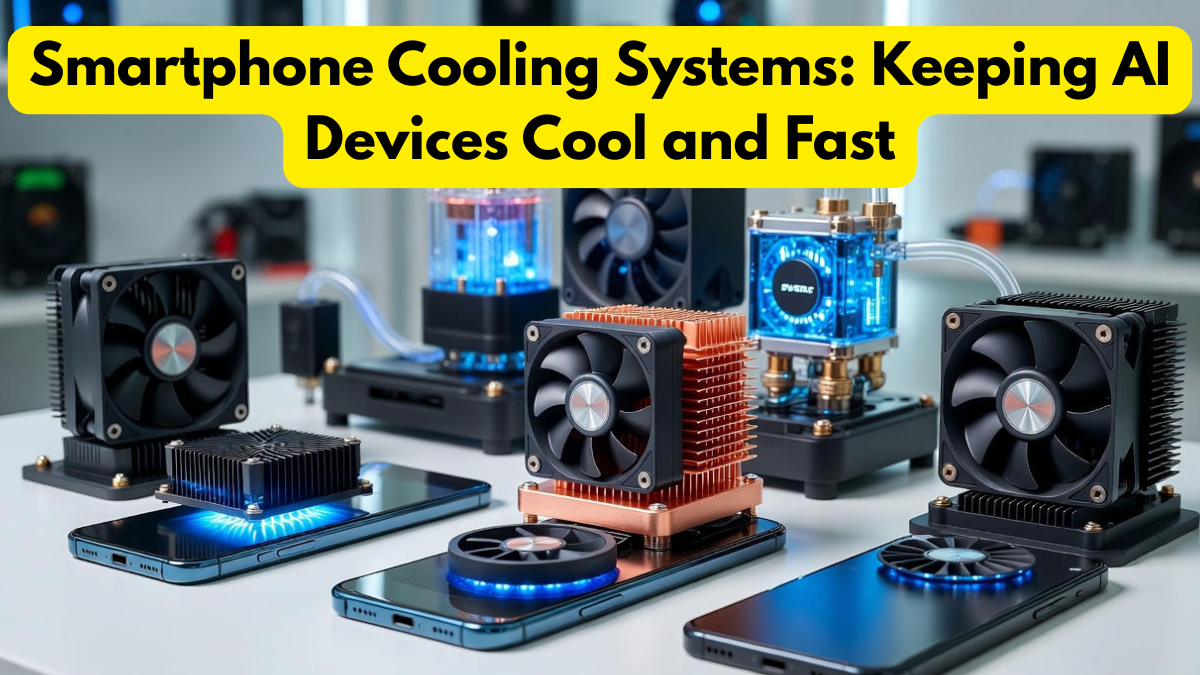The modern smartphone has evolved into a powerful handheld computer, capable of performing complex tasks once limited to desktops. With this power surge comes a significant challenge: heat. As devices get thinner and processors get smarter, the need for an efficient smartphone cooling system has become more critical than ever. This is especially true as phones now use an advanced AI processor to handle tasks like image recognition, real-time translation, and augmented reality. Managing heat effectively is the key to maintaining both performance and longevity, ensuring that the smartphone stays cool, fast, and reliable.

Why Smartphone Cooling Systems Are Essential
Every high-performance phone today generates heat while performing demanding operations. The AI processor inside the device is designed to handle multiple simultaneous tasks, but when it runs continuously, it can overheat, leading to reduced performance or even hardware damage. This is why manufacturers are investing heavily in developing more advanced smartphone cooling system technologies.
Overheating can lead to:
- Slower processing speeds due to thermal throttling
- Reduced battery efficiency
- Shortened hardware lifespan
- Potential device shutdowns during intensive use
By improving cooling mechanisms, smartphone companies ensure that AI processor performance remains stable even under pressure.
How Smartphone Cooling Systems Work
A smartphone cooling system functions by transferring heat away from critical components like the CPU and AI processor to prevent overheating. Traditional methods relied on simple metal plates or graphite layers, but today’s systems are far more advanced. Manufacturers now use vapor chambers, heat pipes, and even liquid-based solutions to efficiently spread and dissipate heat.
Below is a table showing the main types of cooling systems used in modern smartphones:
| Cooling System Type | Description | Common Usage |
|---|---|---|
| Graphite Layer | Spreads heat evenly across internal components | Found in mid-range smartphones |
| Vapor Chamber | Uses a small amount of liquid to absorb and disperse heat | Used in high-end gaming phones |
| Heat Pipe | Metal tube filled with coolant that transfers heat away from the processor | Common in performance phones |
| Liquid Cooling | Circulates coolant fluid through microchannels | Seen in flagship phones and gaming devices |
The AI processor benefits directly from these systems, as it can run complex machine learning operations without being slowed down by temperature spikes.
The Role of AI Processors in Heat Generation
The AI processor is the brain behind many of today’s most intelligent smartphone features—facial recognition, scene detection, voice assistants, and predictive text all rely on it. However, as these AI models grow more complex, they demand more processing power, which generates more heat.
Smartphone cooling system designs are now optimized specifically for AI-driven performance. Instead of only focusing on the CPU and GPU, new thermal designs consider the heat patterns produced by neural processing units (NPUs). This ensures that AI computations can run continuously without affecting performance or user comfort.
In recent flagship models, companies like Samsung, Apple, and OnePlus have improved the placement of the AI processor and redesigned internal layouts to optimize airflow and heat dissipation. The result is a smoother experience when gaming, streaming, or multitasking—all while maintaining ideal device temperatures.
Innovations in Smartphone Cooling Technology
As AI-powered applications continue to grow, innovations in smartphone cooling system design are keeping pace. Some brands have even introduced active cooling accessories, such as attachable mini fans, to enhance cooling efficiency during gaming sessions or extended use. Additionally, phase-change materials (PCMs) are being explored—these materials absorb excess heat and release it slowly over time, helping stabilize temperature fluctuations.
Key innovations include:
- Graphene sheets for superior heat conductivity
- Vapor chamber expansion for enhanced area coverage
- AI-controlled cooling optimization that adjusts system performance dynamically
- Eco-friendly cooling solutions using sustainable materials
By integrating these technologies, smartphone manufacturers can allow the AI processor to run at peak capacity while ensuring energy efficiency and safety.
The Future of Cooling in AI Smartphones
As smartphone AI capabilities expand—handling on-device learning, real-time 3D rendering, and even edge computing—the demand for smarter smartphone cooling system designs will only increase. Future solutions may involve microfluidic cooling, where liquid circulates through channels thinner than a strand of hair, or advanced materials that can adapt their thermal conductivity automatically.
In addition, AI itself may soon help manage temperature more intelligently. By predicting heating patterns in real time, the AI processor could regulate its own clock speed, adjust voltage, or shift workloads between cores, reducing the need for passive cooling components. This kind of self-regulating thermal management marks the next phase of smart device evolution.
Conclusion
The smartphone cooling system has become one of the most critical components of modern mobile engineering. As the AI processor grows more capable and complex, keeping temperatures under control ensures consistent speed, battery efficiency, and safety. Today’s innovations—from vapor chambers to liquid cooling—represent just the beginning. The future will see smarter, AI-driven thermal management that not only cools the phone but optimizes its entire operation. In the race to make smartphones faster and smarter, the coolest device—literally—will always lead.
FAQs
What is a smartphone cooling system?
A smartphone cooling system is a mechanism that helps dissipate heat generated by internal components, especially the CPU and AI processor, to maintain optimal performance.
How does the AI processor affect smartphone temperature?
The AI processor performs complex computations, generating significant heat, which makes an efficient cooling system essential for stability and performance.
What are the best cooling methods used in modern smartphones?
Vapor chambers, liquid cooling, and graphite layers are among the most popular and effective cooling technologies in current smartphones.
Can overheating damage a smartphone?
Yes, excessive heat can lead to slower performance, reduced battery life, and potential hardware failure if not properly managed.
How will smartphone cooling systems evolve in the future?
Future systems will use intelligent AI-based thermal management and adaptive materials to automatically regulate temperature and improve efficiency.
Click here to learn more